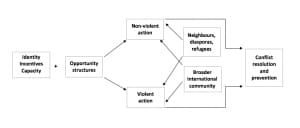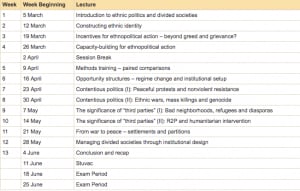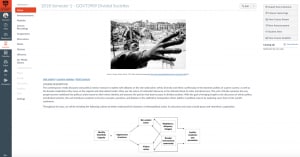As the new semester looms closer and with it the deadlines for having your unit outlines ready, here’s an idea for making the units we teach more internally sound. For the past three years I have been applying the concept of systemism in designing my GOVT3989 Divided Societies class. The basic principle of systemism dictates all problems in social sciences can and should be approached in a systemic rather than sectoral fashion. The main impetus for this has been a realisation that we face an ever-increasing amount of research findings and new theoretical contributions, yet we seem to be lagging behind in their integration into coherent knowledge. A number of scholars in my field have been advocating a visual turn that sketches out the more recent, as well as classical, insights as part of a broader system.
From my experience, designing a unit of study as a system which brings together what at first appear as disparate components of scholarly work helps make sense of the field and makes students realise how “wicked problems” such as ethnic conflicts and managing divided societies have to be tackled from a number of angles.
How do you do it?
Ethnic politics is a vast subject area which largely builds on political science literature, though in earnest is rather multidisciplinary, and covers everything from the study of ethnic identity all the way to institutional design to resolve and manage ethnic conflict. This is a broad subject matter and it can often seem that the different topics covered in this field are not closely related. Indeed, if one teaches these topics individually, without trying to bridge the divides and point to them as components of a larger system, it is hard to understand how ethnic conflicts arise and what can be done to deal with them once they emerge.

This is why I have designed the delivery of my GOVT3989 Divided Societies class as a system for analysing ethnic conflict. There are 12 distinctive modules that make the integral parts of ‘the model’ which begins with the aetiology of ethnic mobilization (i.e. studying the nature of ethnic identity, incentives for organising along ethnic lines, capacity-building for such action and opportunity structures that enable it); observes the different ethnically-motivated political actions (from non-violent resistance all the way to full-scale wars); examines the involvement of external parties in escalating and mitigating the conflicts; and concludes with the prescriptions for conflict resolution and prevention based on the factors covered in previous modules.

Throughout the unit, students are asked to apply this theoretical framework in their tutorial activities, conflict analysis reports and their final take-home exams in order to analyse the origins of a number of ethnic conflicts and offer solutions for their resolution. The course schema connects all the weeks’ themes into a system analysis of ethnic conflicts, while the weekly modules are laid out accordingly.
I advertise the schema on the home page of the Canvas site. It is also the first slide in each of the weekly lecture presentations, noting where we were at in our theoretical model and how a particular week we are analysing relates to other components in the model.

Does it work?
I believe a turn to systemism is something most units senior units in social sciences (and beyond!) can have incorporated in their unit design. The unit had an overall 4.5 satisfaction rate in 2017 and 2018. This is some of the select feedback on the clarity of content and material from the USS reports in these years:
- The lectures and tutorials were incredibly engaging and were very informative in clearly mapping out the course content. The interactive tutorial activities were a helpful method of covering the theory from the readings in a more practical sense.
- Material was always presented in a clear and intellectually challenging manner.
- … the unit structure was extremely clear and logical. Tutorials were varied and challenging, they really complemented the lectures and were well facilitated.
- It is also evident that Gorana is an expert in the field so it is interesting to see her studies as practical case examples to the topics we are looking at.





